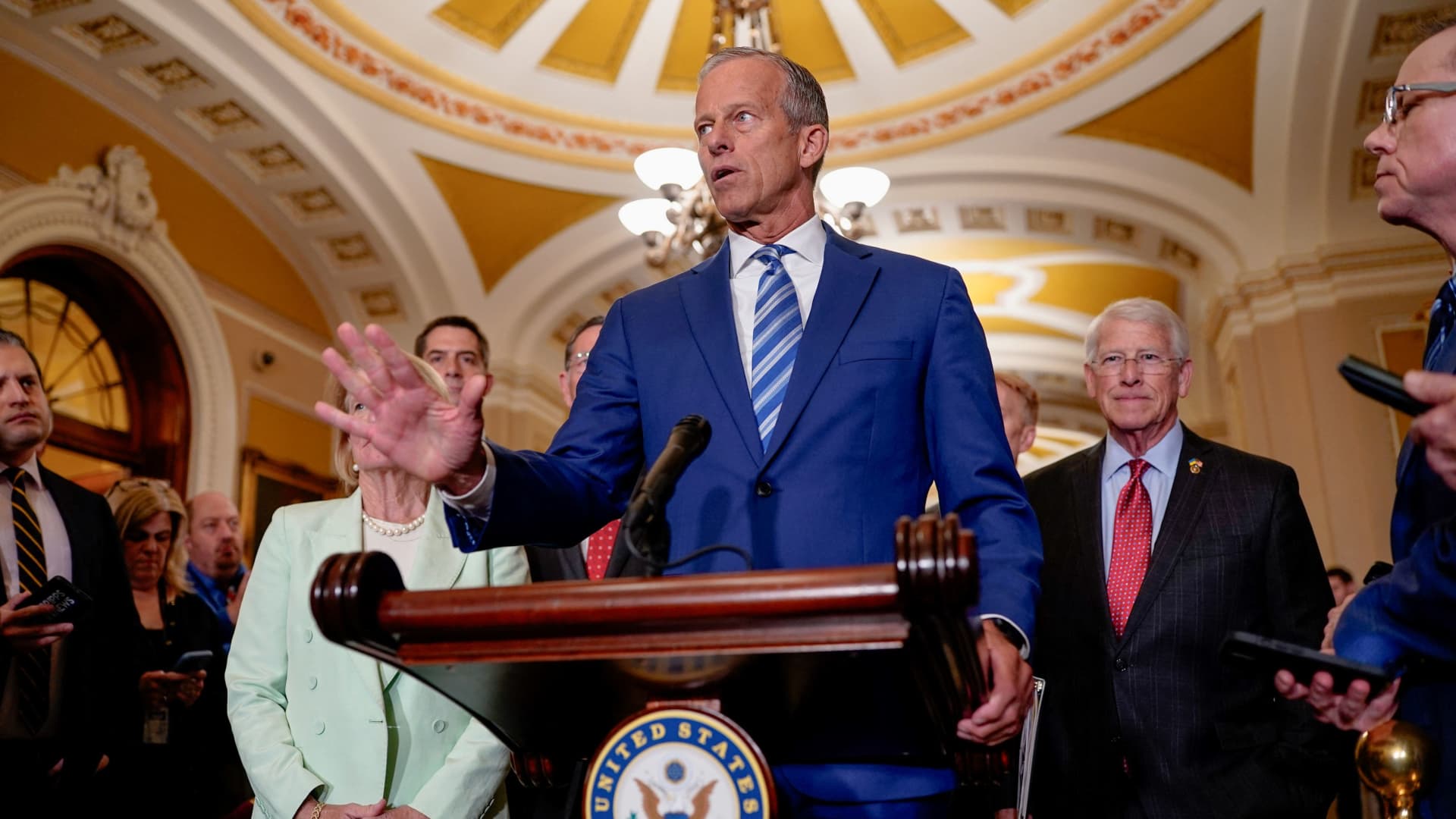Taking an affordable vacation is easy, accountant Krystal Todd suggests in her TikTok videos: Schedule some meetings, call it a business trip and deduct it from your taxes.
Personal Finance
Bad tax advice is multiplying on TikTok
Published
1 year agoon

But offline, she says viewers might need more information than the tax tips in her videos.
“I’m a CPA, but I’m not your CPA,” she said of her social media content. “It’s financial education, not financial advice.”
As the April 15 filing deadline approaches, aggressive tax advice is booming online, especially on the popular video sharing app TikTok. The Internal Revenue Service, though, says a lot of the advice is dubious, exposing unwitting taxpayers to potential fines if they try to carry it out. Bad tax advice has been a problem for generations, but it spreads far more easily on social media than it did in the pre-internet days.
The tips that pop up on TikTok and on Instagram and Facebook, both owned by Meta, make splashy claims that promise big returns. One influencer, Karlton Dennis, says to buy short-term rental properties that lose money on paper, and use that to offset income from your full-time job. Another, Candy Valentino, tells followers to hire their children as employees and deduct some of their housing costs as a business expense — and if their accountant warns that could cause an audit, their accountant is wrong. Still others tell hundreds of thousands of followers to buy 6,000-pound vehicles, then write off the sticker price, maintenance and fuel.
Some creators’ videos go much further, urging people not to pay taxes at all: “Taxes are a scam.” “There’s no law to pay taxes.” “Paying taxes is voluntary.” All of those claims are false.
A TikTok spokesperson said the company removes what it deems to be scams or fraud from its platform, and promotes “best practices” when engaging with online financial content. The site prohibits content that involves the “coordination, facilitation, or instructions on how to carry out scams.” And TikTok’s financial decisions guide tells users to seek “credible sources to cross-check financial guidance.”
Meta declined a request to comment.
In reality, taxpayers can’t deduct salaries they pay their children unless the children truly are gainfully employed, and they can’t deduct the full cost of a fancy new vehicle unless the car is used to run a business, not for personal use. Deducting business trips from your taxes can be legal — but it’s more complicated than just scheduling a meeting during your vacation, and experts suggest keeping business transactions and personal transactions separate to avoid red flags for audits.
And taxes are legal — and not at all voluntary.
“This is not a new phenomenon in any way. The challenge is, on the social media platforms, that the availability of these messages is so much broader,” one recent former top IRS official said. The person spoke on the condition of anonymity to discuss nonpublic agency policy. “Twenty or 30 years ago, this was something your brother-in-law handed around in a shady pamphlet on the weekends.”
Congress and the Biden administration are already concerned about TikTok for other reasons: Worries over Chinese access to the app’s user data led the House in March to vote to force its parent company ByteDance to sell the site to U.S. owners, lest it face a nationwide ban. The Senate is considering the measure. (Tax misinformation spreads on U.S.-based apps, too.)
Many of the influencers posting tax tip videos post a range of advice, much of which is sounder and less aggressive than the most eye-catching videos about big deductions. Several of them made clear in interviews that they do understand the nuances of tax law. The videos serve mostly to draw attention to their content — and to help promote the idea that their financial advice, in general, will lead to riches. Many refer viewers to other products — including stock tips, books and online courses — after offering questionable tax tips.
“I bought a $70,000 truck late last year to save more than $21,000 on my taxes,” Mike Poarch said in a video promoting what he calls a “tax hack.” The purchase, he said, “now allows me to write off all of my gas, which is about $70 a week, plus my insurance, which is like $350 a month, plus all of the maintenance and all of the upgrades.”
In an interview, Poarch acknowledged that only business use of the vehicle is deductible, not personal use: “Sometimes these videos make it appear a little more rosy than it may actually be, but that’s to help with virality.”
Todd said she thinks of her TikTok videos as educational tools, especially for young women of color like her. She explains in her videos how someone should fill out tax forms when starting a new job, for example. She said she tries to give people a more positive and nuanced outlook by talking about reasons it might be good not to get a refund, and how taxes shape society in beneficial ways. Like many TikTokers, Todd said she believes the advice she gives her in-person, paying clients as a certified professional accountant is held to a higher standard for accuracy than the advice she gives online.
Intuit in a statement said its collaboration with Todd was part of the company’s “efforts to provide career opportunities for bookkeepers, and is not an endorsement of other content.” It urged consumers to “be mindful of tax and financial advice on social media.” Representatives for TaxSlayer did not respond to requests for comment.
Todd removed videos promoting TaxSlayer products and links to TaxSlayer discounts from her social media pages and personal website after an interview and after The Washington Post asked TaxSlayer about her affiliation with the company.
Frequently, influencers said their videos were deliberately flattening important context around tax law.
In one recent clip, Will Myers, who makes videos for his 421,700 TikTok followers and 173,000 Instagram followers under the name Money Man Myers, said he helped one client swing their tax return from owing the IRS more than $146,000 to getting a $16,000 refund, using strategies such as hiring the client’s children for their business.
When a reporter asked — really? — Myers conceded, “They have to do real work. The job has to match their age. You can’t say your 4-year-old is driving.” And he showed his detailed knowledge of tax law, even citing the case number of a tax court decision on the question of hiring a child.
Dennis did not respond to requests to comment on his videos, and Valentino said she would only participate in an interview if The Post paid her for her time, which is against standard journalistic ethics.
Thomas Fattorusso Jr., the special agent in charge of the IRS’s criminal investigations division for New York, said his department is aware of social media trends — he mentioned the common videos about hiring children and buying trucks, specifically, in an interview, but declined to discuss individual investigations.
He noted that social media influencers might not be directly profiting from an incorrect tax return generated by a person who listens to their online tips in the way that a tax preparer who lies on a client’s tax return directly profits. Influencers aren’t charging clients to submit returns based on their bad advice. But many do make money on their videos, whether directly on the social media platform or by using the platform to sell a product like a course on financial strategies.
Even though the influencers aren’t acting as the tax preparer or adviser for followers on social media, advice that they give could in theory make them a “promoter” in the eyes of the IRS. Fattorusso described a “promoter” as someone who knowingly disseminates a tax fraud scheme, which means they could come under criminal investigation, he said: “You are promoting this. There’s a willful intent to what you’re doing in telling people they can do this when you know they can’t and it’s illegal.”
Fattorusso’s office pointed to other tax promoter cases as examples, though none of those defendants’ activities were solely on social media.
Making a case against an influencer just because of bad tax advice in videos would be immensely difficult, said Nina Olson, who served as the National Taxpayer Advocate, the IRS’s internal watchdog, from 2001 to 2019. In that role, she campaigned for Congress to expand the IRS’s authority to regulate tax preparers and others who offer tax advice.
IRS investigators would have to identify a similar problem on a large number of tax returns, audit those taxpayers and trace the deficiencies of the tax filings to the same online influencer.
“You can’t stop people from saying stupid things,” Olson said. “It’s when they’re monetizing stupid things and you can make a tie to someone else’s act, relying on what they said.”
And some TikTok tax tippers have begun hedging their language to avoid legal pitfalls, said Caroline Bruckner, who studies tax administration and financial literacy at American University’s Kogod Tax Policy Center. Adding phrases like “Take a look at” or “In my opinion” ahead of sharing questionable tax advice could insulate content creators from legal consequences, she said.
Maryland accountant Nick Krop, 30, has been making videos since 2021 in which he frequently shows a snippet of another social media creator’s tax advice, then says why it’s wrong. Reacting to a video that advised putting assets into a trust to avoid taxes, Krop marveled, “It’s not true, a work of fiction, a complete fabrication. … A trust is not a magical entity that will shield you from taxes.” On a video that claimed whole life insurance could be used to avoid taxes, Krop commented, “Good rule of thumb: if it was that easy to reduce your taxable income to nothing, everyone would be doing that.”
He said even some of his own clients who work from home have asked if they can write off new cars — which seems inherently dubious.
Krop, like every TikTok creator interviewed for this story, said he doesn’t think the government should police what anyone says on social media about taxes. But he does think TikTok should put its thumb on the scale to make sure users see correct tax advice more often than incorrect: “It would be nice if TikTok would elevate those people who are trying to correct the record.”
You may like
Personal Finance
‘SALT’ deduction in limbo as Senate Republicans unveil tax plan
Published
7 hours agoon
June 16, 2025
U.S. Senate Majority Leader John Thune (R-SD) speaks at a press conference following the U.S. Senate Republicans’ weekly policy luncheon on Capitol Hill in Washington, D.C., U.S., June 10, 2025.
Kent Nishimura | Reuters
As Senate Republicans release key details of President Donald Trump‘s spending package, some provisions, including the federal deduction for state and local taxes, known as SALT, remain in limbo.
Enacted via the Tax Cuts and Jobs Act, or TCJA, of 2017, there’s currently a $10,000 limit on the SALT deduction through 2025. Before 2018, the tax break — including state and local income and property taxes — was unlimited for filers who itemized deductions. But the so-called alternative minimum tax reduced the benefit for some higher earners.
The Senate Finance Committee’s proposed text released on Monday includes a $10,000 SALT deduction cap, which is expected to change during Senate-House negotiations on the spending package. That limit is down from the $40,000 cap approved by House Republicans in May.
More from Personal Finance:
Fed is likely to hold rates steady this week. What it means for you
How to protect assets amid immigration raids, deportation worries
IRS: Make your second-quarter estimated tax payment by June 16
The SALT deduction has been ‘contentious’
“SALT has been contentious for eight years,” said Andrew Lautz, associate director for the Bipartisan Policy Center’s economic policy program.
Since 2017, the SALT deduction cap has been a key issue for certain lawmakers in high-tax states like New York, New Jersey and California. These House members have leverage during negotiations amid a slim House Republican majority.
Under current law, filers who itemize tax breaks can’t claim more than $10,000 for the SALT deduction, including married couples filing jointly, which is considered a “marriage penalty.”

However, raising the SALT deduction cap has been controversial. If enacted, benefits would primarily flow to higher-income households, according to a May analysis from the Committee for a Responsible Federal Budget.
Currently, the vast majority of filers — roughly 90%, according to the latest IRS data — use the standard deduction and don’t benefit from itemized tax breaks.
Plus, the 2017 SALT cap was enacted to help pay for other TCJA tax breaks, and some lawmakers support the lower limit for funding purposes.
In the Senate, “there isn’t a high level of interest in doing anything on SALT,” Senate Majority Leader John Thune said June 15 on “Fox News Sunday.”
“I think at the end of the day, we’ll find a landing spot, hopefully that will get the votes that we need in the House, a compromise position on the SALT issue,” he said.
But some House Republicans have already pushed back on the proposed $10,000 SALT deduction cap included in the Senate draft.
Rep. Mike Lawler, R-N.Y., on Monday described the Senate proposed $10,000 SALT deduction limit as “DEAD ON ARRIVAL” in an X post.
Meanwhile, Rep. Nicole Malliotakis, R-N.Y., on Monday also posted about the $10,000 cap on X. She said the lower limit was “not only insulting but a slap in the face to the Republican districts that delivered our majority and trifecta.”
Personal Finance
Welcome to the zoo. That’ll be $47 today — ask again tomorrow.
Published
12 hours agoon
June 16, 2025
Giant panda Bao Li chews on bamboo during his public debut at the Smithsonian’s National Zoo in Washington, U.S., January 24, 2025.
Kevin Lamarque | Reuters
How much will it cost to visit a museum, zoo or aquarium this summer? The answer, increasingly, is: It depends.
John Linehan can rattle off almost two dozen factors that Zoo New England’s dynamic pricing contractor, Digonex, uses to recommend what to charge guests.
“It’s complicated,” said Linehan, president and CEO of the operator of the two zoos in eastern Massachusetts.
Before adopting dynamic pricing, the organization was changing prices seasonally and increasing entry rates little by little. “As we watched that pattern, we were afraid some families were going to get priced out,” he said of the earlier approach. “I’m a father of four and I know what it is like.”
Now, Zoo New England’s system provides cheaper rates for tickets purchased far in advance. That, coupled with the zoo’s participation in the Mass Cultural Council’s discounted admissions program for low-income and working families, “puts some control back in the consumer’s hands,” Linehan said.
We charge what we need to make ends meet while delivering on our mission.
John Linehan
CEO of Zoo New England
The zoo is one of many attractions embracing pricing systems that were earlier pioneered by airlines, ride-hailing apps and theme parks. While these practices allow operators to lower prices when demand is soft, they also enable the reverse, threatening to squeeze consumers who are increasingly trimming their summer travel budgets.
Before the pandemic, less than 1% of attractions surveyed by Arival, a tourism market research and events firm, used variable or dynamic pricing. Today, 17% use variable pricing, in which entry fees are adjusted based on predictable factors such as the day of the week or the season, Arival said. And 6% use dynamic pricing, in which historical and real-time data on weather, staffing, demand patterns and more influence rates.
The changes come as barely half of U.S. museums, zoos, science centers and similar institutions have fully recovered to their pre-Covid attendance levels, according to the American Alliance of Museums. That has led many to pursue novel ways of filling budget gaps and offsetting cost increases.
“There’s a saying: ‘No margin, no mission,'” Linehan said, “and we charge what we need to make ends meet while delivering on our mission.”
Entry costs are climbing even at attractions that aren’t using price-setting technology. The broad “admissions” category in the federal government’s Consumer Price Index, which includes museum fees alongside sports and concert tickets, climbed 3.9% in May from the year before, well above the annual 2.4% inflation rate.
In 2024, the nonprofit Monterey Bay Aquarium raised adult ticket prices from $59.95 to $65 and recently upped its individual membership rate, which includes year-round admission, from $95 to $125. “Gate admission from ticket sales funds the core operation of the aquarium,” a spokesperson said.
While the Denver Art Museum has no plans to test dynamic pricing, it raised admissions fees last fall, three years after a $175 million renovation and a survey of ticket prices elsewhere, a spokesperson said. Entry costs went from $18 to $22 for Colorado residents and from $22 to $27 for out-of-state visitors. Prices rise on weekends and during busy times, to $25 and $30 for in- and out-of-state visitors, respectively. Guests under age 19 always get in free thanks to a sponsored program.
Some attractions are doing a daily analysis of their bookings over the next several days or weeks and making adjustments.
Douglas Quinby
CEO of Arival
Like many attractions, the art museum posts these prices on its website. But many attractions’ publicly listed ticket prices are liable to fluctuate. The Seattle Aquarium — which raised its price ranges last summer by about $10 ahead of the opening of a new ocean pavilion — also uses Digonex’s algorithmic recommendations.
During the week of June 8, for example, the aquarium’s online visit planner, which displays the relative ticket availability for each day, offered out-of-state adult admissions as low as $37.95 for dates later in the month and as much as $46.95 for walk-in tickets that week. In addition to booking in advance, there are more than half a dozen other discounts available to certain guests, including seniors and tribal and military members, a spokesperson noted.
At many attractions, however, admission fees aren’t even provided until a guest enters the specific day and time they want to visit — making it difficult to know that lower prices may be available at another time.
“Some attractions are doing a daily analysis of their bookings over the next several days or weeks and making adjustments” to prices continuously, said Arival CEO Douglas Quinby. Prices might rise quietly on a day when slots are filling up and dip when tickets don’t seem to be moving, he said.
Digonex, which says it provides automated dynamic pricing services to more than 70 attractions worldwide, offers recommendations as frequently as daily. It’s up to clients to decide how and whether to implement them, a spokesperson said. Each algorithm is tailored to organizations’ goals and can account for everything from weather to capacity constraints and even Google Analytics search patterns.
Data-driven pricing can be “a financial win for both the public and the museum,” said Elizabeth Merritt, vice president of strategic foresight at the American Alliance of Museums. It can reduce overcrowding, she said, while steering budget-minded guests toward dates that are both cheaper and less busy.
The stegosaurus fossil nicknamed Apex is unveiled to the media at the American Museum of Natural History in New York, December 5, 2024. Billionaire Kenneth C. Griffin, who bought the stegosaurus fossil for $44.6 million, is loaning it to the museum for four years.
Timothy A. Clary | Afp | Getty Images
But steeper prices during peak periods and for short-notice visits could rankle guests — who may see anything less than a top-notch experience as a rip-off, said Stephen Pratt, a professor at the University of Central Florida’s Rosen College of Hospitality Management who studies tourism.
“Because of the higher prices, you want an experience that’s really great,” he said, transforming a low-key day at the zoo into a big-ticket, high-stakes outing. “You’ve invested this money into family time, into creating memories, and you don’t want any service mishaps.”
That could raise the risk of blowback at many attractions, especially those grappling with Trump administration cuts this summer. Some historic sites and national parks have already warned that their operations are under pressure.
Consumers should expect more price complexity to come. Arival said 16% of attractions ranked implementing dynamic pricing as a top priority for 2025-26. Among large attractions serving at least half a million guests annually, 37% are prioritizing dynamic pricing, up from the 12% that use it currently.
For visitors, that could mean hunting harder for cheaper tickets. While many museums are free year-round, others provide lower rates for off-season visits and those booked in advance. It’s also common to reduce or waive fees on certain days or hours, and many kids and seniors can often get discounted entry.
Here are a few other ways to keep admissions costs low:
Ways to save on museum tickets:
- Ask your local library. Many have museum passes that cardholders can check out.
- Bundling programs such as CityPass, GetOutPass, Go City and others allow visitors to save money on admissions to a range of attractions.
- Bank of America’s Museums on Us program offers cardholders free entry to many institutions during the first full weekend of each month.
- For the past decade, Museums for All has been providing free or reduced entry at more 1,400 U.S. museums and attractions to anyone receiving SNAP food assistance benefits.
- And each summer, the Blue Star Museums program offers museum discounts to actively serving military personnel and their families.
“It may take a bit of research,” said Quinby, “but it’s still possible to find a good deal.”

U.S. President Donald Trump looks on as Fed Chair Jerome Powell speaks at the White House in Washington on Nov. 2, 2017.
Carlos Barria | Reuters
Political pressure is mounting against the Federal Reserve Chair Jerome Powell, and yet the Federal Reserve is expected to hold interest rates steady at the end of its two-day meeting this week.
Despite a wave of recent attacks on Powell from President Donald Trump, futures market pricing is implying virtually no chance of an interest rate cut, according to the CME Group’s FedWatch gauge.
The president has argued that maintaining a fed funds rate that is too high makes it harder for businesses and consumers to borrow, adding more strain to the U.S. economy. The federal funds rate sets what banks charge each other for overnight lending, but also affects many of the borrowing and savings rates most Americans see every day.
More from Personal Finance:
Here’s the inflation breakdown for May 2025
What’s happening with unemployed Americans — in five charts
The economic cost of Trump, Harvard battle over student visas
With a rate cut likely postponed until at least September, consumers struggling under the weight of high prices and high borrowing costs aren’t getting much relief, experts say.
“The combination of high interest rates, stubborn inflation and economic uncertainty is a pretty challenging one,” said Matt Schulz, chief credit analyst at LendingTree. “Most Americans don’t have a ton of wiggle room and today they have even less.”
From credit cards and mortgage rates to auto loans and savings accounts, here’s a look at how the Fed plays a role in your finances.
Credit cards
Credit card debt continues to be a pain point for consumers struggling to keep up with high prices. Since most credit cards have a variable rate, there’s a direct connection to the Fed’s benchmark.
But even with the Fed on the sidelines, credit card rates have edged higher. The average annual percentage rate is currently just over 20%, according to Bankrate, not far from last year’s all-time high.
“This is a sign of banks trying to protect themselves from the risk that is out there in these uncertain times,” Schulz said. However, in this case, there is something consumers can do about higher APRs.

“The truth is that people have way more power over the rates they pay than they think they do, especially if they have good credit,” Schulz said.
Rather than wait for a rate cut that may be months away, borrowers could switch now to a zero-interest balance transfer credit card or consolidate and pay off high-interest credit cards with a lower-rate personal loan, he said.
Mortgages
Since 15- and 30-year mortgages are largely tied to Treasury yields and the economy, those rates haven’t moved much — and that hasn’t helped would-be buyers.
The average rate for a 30-year, fixed-rate mortgage has stayed within the same narrow range for months and is currently near 6.9%, according to Bankrate. Tack on the nationwide problem of limited inventory and housing affordability remains a key issue, regardless of the Fed’s next move.
“I don’t see any major changes coming in the immediate future, meaning that those shopping for a home this summer should expect rates to remain relatively high,” Schulz said.
Auto loans
Auto loan rates are fixed, and not directly tied to the Fed. But payments are getting bigger because car prices are rising, in part due to impacts from Trump’s trade policy.
Currently, the average rate on a five-year new car loan is 7.24%, according to Bankrate.
The growth in median car payments is outpacing both new and used car prices, according to separate data from Bank of America. Now, of those households with a monthly car payment, 20% pay more than $1,000 a month.
“Combine that with the potential for tariffs to drive auto prices even higher, and it adds up to a really challenging time to buy a car,” Schulz said. “However, shopping for the best rate and getting approved for financing before you ever set foot in the dealership can bring significant savings,” he added.
Student loans
Federal student loan rates are set once a year, based in part on the last 10-year Treasury note auction in May and fixed for the life of the loan, so most borrowers are somewhat shielded from Fed moves and recent economic turmoil.
Current interest rates on undergraduate federal student loans made through June 30 are at 6.53%. Starting July 1, the interest rates will be 6.39%.
Although borrowers with existing federal student debt balances won’t see their rates change, many are now facing other headwinds and fewer federal loan forgiveness options.
Savings
On the upside, top-yielding online savings accounts still offer above-average returns and currently pay more than 4%, according to Bankrate.
While the central bank has no direct influence on deposit rates, the yields tend to be correlated to changes in the target federal funds rate — so holding that rate unchanged has kept savings rates elevated, for now.
“The thing that is lost in this, is that savers, including millions of retirees, are actually earning good income on their savings, provided they have their money parked in a competitive place,” said Greg McBride, Bankrate’s chief financial analyst.

Senate Republicans release revised tax cuts and debt limit bill

Tax savings for business owners hiring kids

‘SALT’ deduction in limbo as Senate Republicans unveil tax plan

New 2023 K-1 instructions stir the CAMT pot for partnerships and corporations

The Essential Practice of Bank and Credit Card Statement Reconciliation

Are American progressives making themselves sad?
Trending
-

 Economics1 week ago
Economics1 week agoSending the National Guard to LA is not about stopping rioting
-

 Blog Post1 week ago
Blog Post1 week agoMastering Bookkeeping Tasks During Peak Business Seasons
-

 Accounting1 week ago
Accounting1 week agoInstead adds AI-driven tax reports
-

 Personal Finance1 week ago
Personal Finance1 week agoWhat Pell Grant changes in Trump budget, House tax bill mean for students
-

 Personal Finance6 days ago
Personal Finance6 days agoHow markets performed for investors so far
-

 Economics6 days ago
Economics6 days agoIs there a “woke right” in America?
-

 Personal Finance7 days ago
Personal Finance7 days agoTrump’s ‘big beautiful’ bill may curb access to low-income tax credit
-

 Finance6 days ago
Finance6 days agoGundlach says to buy international stocks on dollar’s ‘secular decline’
